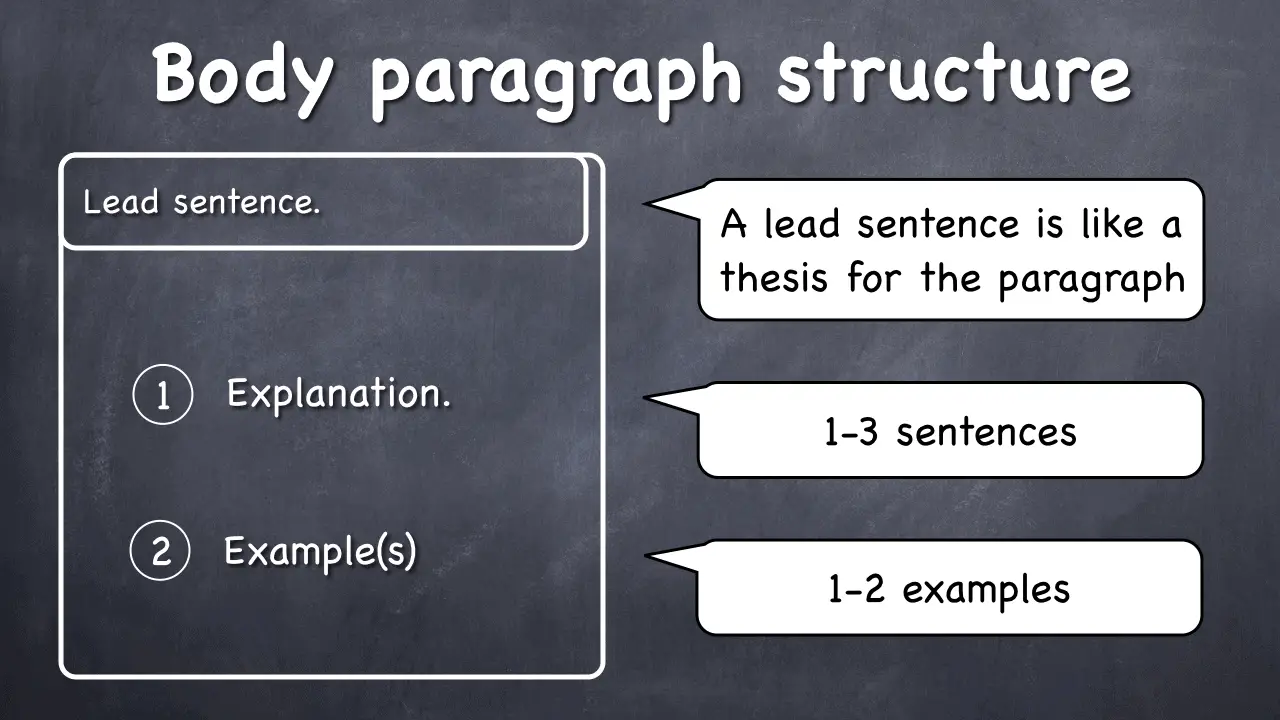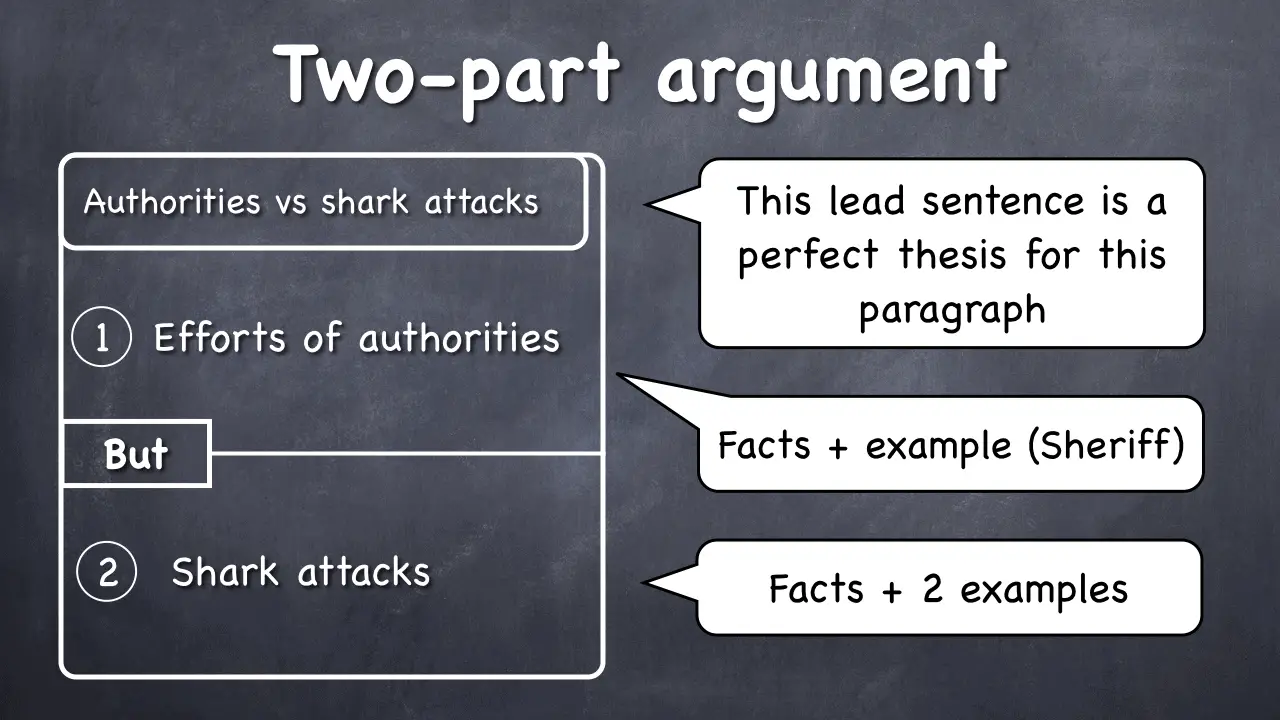A body paragraph in an essay consists of three parts: topic sentence, explanation, and one or more examples. The topic sentence summarizes your paragraph completely and perfectly. The explanation is used to discuss and clarify the main point of your paragraph. And examples illustrate the point.
I’m Tutor Phil, and in this tutorial I’ll show you how to write great body paragraphs in an expository essay (also known as a position essay or an argumentative essay). It is the most common type of an essay you have to write in college.
If you learn how to write excellent body paragraphs,
- Your thoughts will flow easily
- You will always know what to say to support your thesis
- You’ll be able to expand your essay whenever necessary
- Your reader will have an easy time understanding your arguments
- You will consistently get better grades
What should a good paragraph contain and how do you write one? Here is the short answer.
A basic body paragraph consists of a topic sentence, an explanation, and example(s). To write it, think of a paragraph as a mini-essay in which the topic sentence is like a thesis statement, and the explanation and examples are the support.
Body Paragraphs in an Argumentative Essay
Just to be clear, an argumentative essay is the same as a persuasive, expository, or a so-called opinion essay. It is just an essay in which you present a thesis, or an argument, and then support it using evidence.
And the function of a body paragraph in such an essay is to deliver the evidence effectively.
A few important facts about body paragraphs:
- A body paragraph can be as short as three sentences or as long as a page (in a long research paper).
- It should always proceed from general to specific.
- It should only contain information that helps support the main point in some way.
- It should not contain irrelevant information or contradict the thesis.
If you follow the paragraph structure I’m about to show you, your essays will have amazing persuasive power.
Basic Body Paragraph Structure
Let me show you the three-part structure of a body paragraph that you would write in an essay.

Let’s look closely at each part of a basic body paragraph.
Topic Sentence
A topic sentence (also known as a lead sentence) is the first and most general statement in a body paragraph. It should briefly summarize the contents of the paragraph. This way, it tells the reader what the main point of the paragraph is.
Treat the topic sentence like a thesis for your paragraph. Everything that follows it should serve to support it.
Explanation
This is the part where you explain the point you just made in the topic sentence. It is your opportunity to show your knowledge about the subject.
If you’re writing a basic essay, as you would on a test or an exam, you don’t have to cite sources. Just provide a logical explanation or present facts known to you.
If you are writing a research paper, you should provide well-researched information taken from credible sources and cited.
But this part should still be somewhat general. Here are several kinds of information you can include in the Explanation part:
- A list of facts that support the main point.
- A logical explanation. This will answer the question “Why?”
- A description of a process. This will answer the question “How?”
Example(s)
This is the final part of a paragraph in which you present the most specific bits of evidence. Examples contain dates, names, events, geographical locations, and other specific information.
Examples are fun both for the writer and for the reader. They are an easy way to add quality content to your essay. And readers love them because they contain stories and fun facts.
Enough of theory. Let’s write some body paragraphs.
Body Paragraph Examples
Example 1. New York City
“The abundance of entertainment makes New York an amazingly fun city. The variety of things to do is incredible, and many venues are open all night. Broadway and off-Broadway shows, concert halls, comedy clubs, and all kinds of live music venues are within a hand’s reach. ‘Hamilton’ the musical opened last year to great success. People absolutely love it. Though tickets to the show usually have to be bought way in advance, my uncle and cousin bought theirs on the street and got in that night. They came away dazzled and even wanted to attend the show again during the same visit to the city.”
Let’s break this paragraph down.
First, it begins with a topic sentence that states that NYC is a great place to go if you love entertainment. That is that main point of the paragraph.
Next comes one sentence that is an explanation. It is about the variety and availability of venues. They are many, and they are always open.
Next, we have a list of examples of venues. They are more general examples, but they are examples nevertheless. ‘Hamilton’ is more specific.
And finally, we have the most specific example of specific people who did a specific thing in New York.
Note that the paragraph flows from general to specific. And each sentence serves to support the argument presented in the topic sentence.
Example 2. Sharks
“In spite of the efforts of the local government, shark attacks still take place. Local police, in collaboration with marine scientists, built underwater fences to protect the beach. They also warned local beach goers to exercise caution and stay within marked limits when swimming. Sheriff Peterson personally greeted beach goers for several days, warning them about the danger. Nevertheless, despite all the best efforts, two shark attacks took place last week. A middle-aged man suffered a bite, was rushed to the hospital, and recovered shortly thereafter. A little boy who was attacked two days later survived but had to be treated for serious injuries.”
Let’s take a look at what’s happening in this paragraph.
This one is a little more complex because it has two parts – the efforts of local authorities to prevent shark attacks and the attacks that happened anyway.

The topic sentence summarizes both parts perfectly. This way, it also dictates the structure of the paragraph.
Whenever you use sentence structure “despite A, nevertheless B,” you are creating two parts that are antagonistic to each other.
And that’s a great way to divide a topic or subject into parts. It adds persuasive power and allows you to write more content.
Note that each of the two parts of the paragraph proceeds from general to specific.
The first part begins with the efforts of authorities and ends with the example of the sheriff himself.
The second part begins with a statement of facts. And it ends with two specific examples.
For more body paragraph examples, check out my detailed tutorial for beginners on how to write an essay.
Body Paragraph Writing Tips
Check in with your thesis.
Whenever you’re not sure what to write in your next paragraph, check in with your thesis statement or your outline.
Make sure that this paragraph is relevant to the subject and serves to support the main point of the whole essay. It should definitely not contradict your thesis.
If you have an outline, which you probably should, consult it before writing the paragraph. It will tell you what section you’re in, and what goes into that section.
In other words, start from the head of the paper and gradually arrive at your next paragraph.
Don’t worry if your data is limited.
As long as your paragraph proceeds from general to specific and has a solid topic sentence, you’re doing fine. Here’s what I mean.
Let’s say you have a wonderful logical explanation. But you don’t have any examples. Or you are running out of space and don’t want to include an example.
That’s fine. You don’t have to include an example for every point you make. That said, examples are some of the most attractive and desirable parts of your essay. So, include them when you can.
On the other hand, if all you have is examples, but you don’t have a very good explanation, that works, too.
Just follow up your topic sentence with a bunch of good examples, and your point is well-made.
Don’t worry about concluding sentences or transitions.
You will often hear that you should conclude your paragraph with a sort of a small conclusion. Some experts also advise to use transitions to connect paragraphs.
But you don’t really need to write either one. If your writing is crystal clear, your reader will have no problem following your points.
Concluding sentences are just repetitious. And transitions are usually just fluff.
State your point in the topic sentence, support it with an explanation or examples or both, and proceed to the next paragraph. Keep it simple.
Hope this was helpful!
Now go write some amazing body paragraphs!
Tutor Phil.
